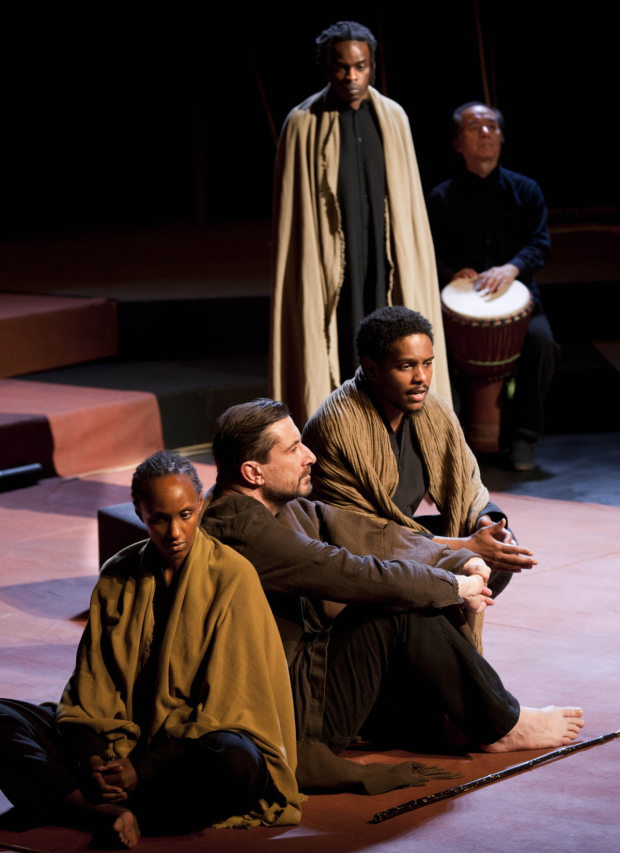Michael Coveney: In its essence, theatre is here today and gone tomorrow
Michael Coveney on the new V&A exhibition ”Curtain Up” and Peter Brook’s ”Battlefield”
Of course you do, and so you'll be going along to the V&A to see the new exhibition Curtain Up designed to celebrate 40 years of the Olivier awards and presented by the Society of London Theatre (SOLT) with the New York Public Library for the Performing Arts at Lincoln Center.
You can see the original top hats in A Chorus Line, the brilliant and luxurious Phantom costumes of the late Maria Bjornson, Rob Howell's forest of letter blocks on the set model of Matilda and Bunny Christie's illuminated floor (as it was in the Cottesloe) for Curious Incident.
Just as criticism is only useful in the context of what went before, so the life of the theatre is rooted in, while reacting against, the past. Historical memory is a thing of the past in itself for many people. But most theatre-goers, and all critics, carry the memory and imprint of past performances into every theatre they visit. How – and whether – they utilise that memory is another matter.
Right next door is another example of "any old cock," Jack Tinker's Daily Mail review of Sarah Kane's Blasted .

© Simon Annand
The disappearance of the V&A's Theatre Museum in Covent Garden was a terrible blow to our theatrical heritage, but the absolute joy of Curtain Up is that it is pointing the public back towards that same collection, or part of it, re-housed in the V&A's theatre and performance galleries surrounding these new exhibits.
So, on leaving the floor of Curious Incident, you discover two display cabinets containing samples from two recently acquired collections: those of Peter Brook and Vivien Leigh. There's a letter to Brook from Harold Pinter apologising for his rude dismissal of US (Brook's anti-Vietnam war protest show for the RSC at the Aldwych in 1966): "The trouble is I find that when I get on television, which I don't very often, I simply talk any old cock that comes into my head."
And right next door is another example of "any old cock," Jack Tinker's Daily Mail review of Sarah Kane's Blasted (on which he later recanted). The value of Tinker's enraged eloquence is that it registers exactly the shock of the new that Kane intended. Blasted was a provocation. Later we realised that it was a very good play, something Pinter himself recognised at the outset.
Similarly, Jocelyn Herbert's wonderful masks and costumes for Peter Hall's great production of The Oresteia at the National evoke the kind of performance Robert Icke's award-winning Almeida version was challenging and contradicting. That's how theatre works, even within the span of a single career. When Peter Brook first directed his nine-hour version of The Mahabharata (the only UK performances were in Glasgow in an atmospheric old tram shed), he re-defined the very notion of heroic theatre in terms of spiritual and athletic endeavour; his current re-visiting of the same material in Battlefield at the Young Vic is a reflective, sombre, very beautiful acceptance of how the world is after decades of carnage and the death of 18 million people in warfare.
You can see the original Mahabharata in a very good Channel 4 DVD, but you can't see much on screen of theatre before 1980. In its essence, theatre is ephemeral, impermanent, here today and gone tomorrow. But the V&A exhibition restores the past in our collective memory and makes us stronger in our appetite and enthusiasm. And as Julian Bird, chief executive of SOLT, said at the curtain up on Curtain Up, we especially need "young people from different backgrounds" to join in, learn about the past, immerse themselves in the present, and ring the changes.
Watch our video on Curtain Up here
Sneak Peek: Curtain Up at the V&A Museum
Here's a sneak peek at the Curtain Up exhibition which opens at the V&A museum tomorrow.
Posted by WhatsOnStage on Monday, 8 February 2016












